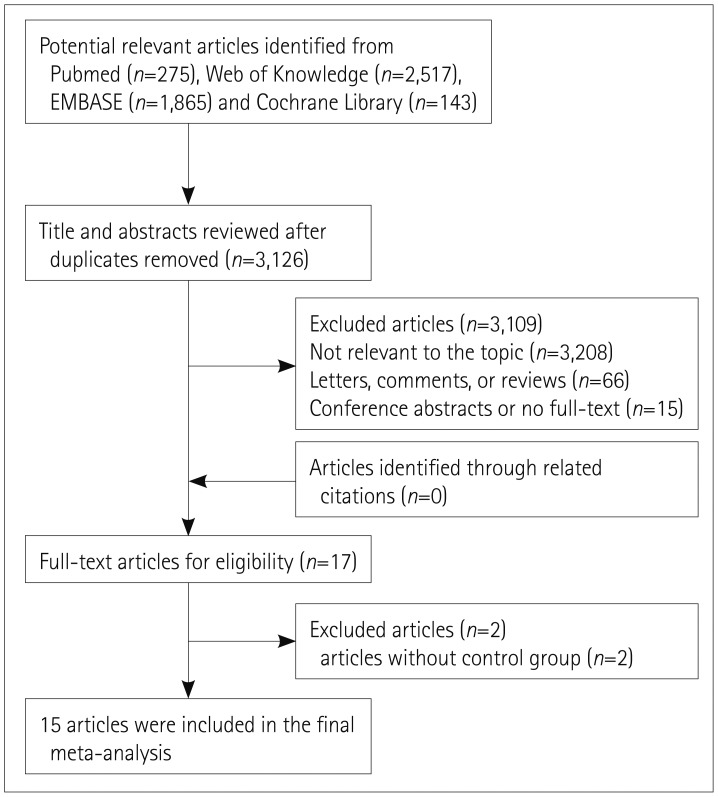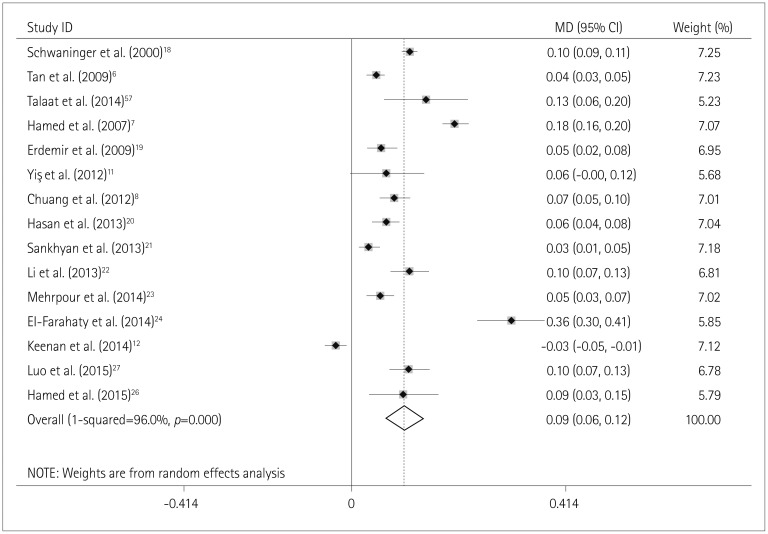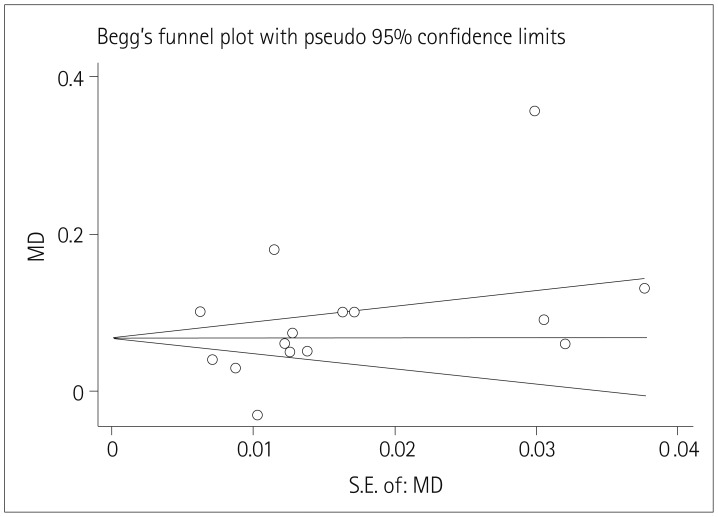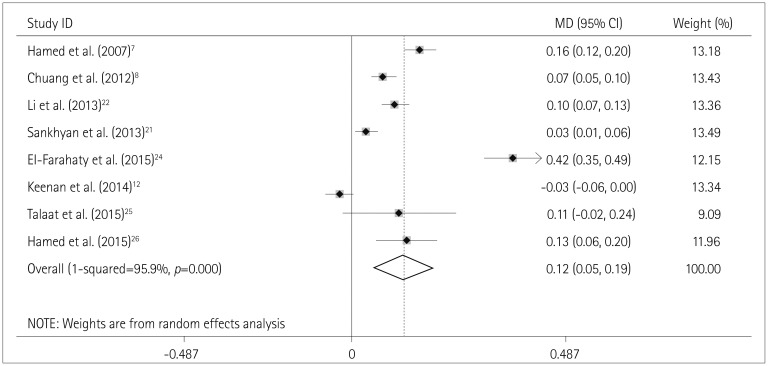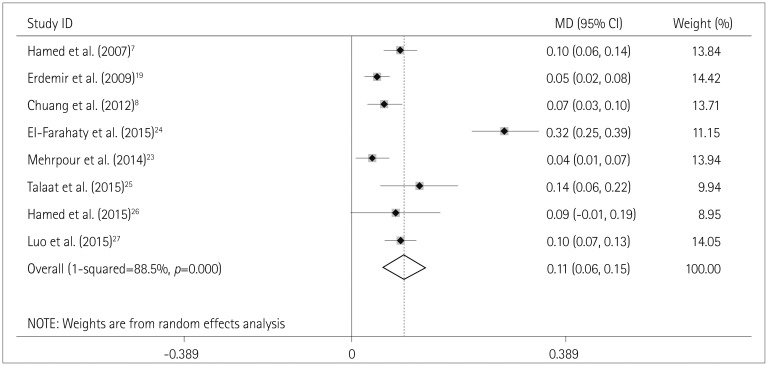J Clin Neurol.
2017 Oct;13(4):371-379. 10.3988/jcn.2017.13.4.371.
Effects of Antiepileptic Drugs on the Carotid Artery Intima-Media Thickness in Epileptic Patients
- Affiliations
-
- 1Department of Neurology, Zhejiang Hospital, Hangzhou, China.
- 2Department of Neurology, Second Affiliated Hospital, School of Medicine, Zhejiang University, Hangzhou, China. meipingd@163.com
- KMID: 2392133
- DOI: http://doi.org/10.3988/jcn.2017.13.4.371
Abstract
- BACKGROUND AND PURPOSE
It has been reported that taking antiepileptic drugs (AEDs) may increase the risk of atherosclerosis. We performed a meta-analysis to evaluate the carotid artery intima-media thickness (CA-IMT) as a surrogate factor for atherosclerosis in epileptic patients.
METHODS
We searched NCBI (PubMed), ISI Web of Knowledge, EMBASE, and the Cochrane Library databases for studies of the association between AEDs and CA-IMT in epileptic patients. A random-effects meta-analysis was used to pool results across studies.
RESULTS
Fifteen studies involving 1,775 epileptic patients were included in the analysis. The overall CA-IMT was significantly larger among users of AEDs [mean difference (MD)=0.09 mm, 95% confidence interval (CI)=0.06-0.12 mm). When stratified by age, the MD was similar in adult patients (MD=0.09 mm, 95% CI=0.06-0.13 mm), but no significant difference was observed in children (MD=0.03 mm, 95% CI=0.00-0.07 mm). Regarding specific AEDs, monotherapy with carbamazepine (CBZ) or valproic acid (VPA) was associated with a larger CA-IMT, while phenytoin monotherapy was not and the result for lamotrigine was inconclusive.
CONCLUSIONS
This study suggests that using AEDs is associated with the CA-IMT in patients with epilepsy, particularly for adult patients. In particular, CBZ and VPA may be related to a significant increase in CA-IMT.
MeSH Terms
Figure
Reference
-
1. Reynolds EH. Introduction: epilepsy in the world. Epilepsia. 2002; 43(Suppl 6):1–3.
Article2. Eddy CM, Rickards HE, Cavanna AE. Behavioral adverse effects of antiepileptic drugs in epilepsy. J Clin Psychopharmacol. 2012; 32:362–375. PMID: 22544012.
Article3. Mintzer S. Metabolic consequences of antiepileptic drugs. Curr Opin Neurol. 2010; 23:164–169. PMID: 20125012.
Article4. Perucca P, Gilliam FG. Adverse effects of antiepileptic drugs. Lancet Neurol. 2012; 11:792–802. PMID: 22832500.
Article5. Shen C, Chen F, Zhang Y, Guo Y, Ding M. Association between use of antiepileptic drugs and fracture risk: a systematic review and metaanalysis. Bone. 2014; 64:246–253. PMID: 24780876.
Article6. Tan TY, Lu CH, Chuang HY, Lin TK, Liou CW, Chang WN, et al. Long-term antiepileptic drug therapy contributes to the acceleration of atherosclerosis. Epilepsia. 2009; 50:1579–1586. PMID: 19292757.
Article7. Hamed SA, Hamed EA, Hamdy R, Nabeshima T. Vascular risk factors and oxidative stress as independent predictors of asymptomatic atherosclerosis in adult patients with epilepsy. Epilepsy Res. 2007; 74:183–192. PMID: 17448640.
Article8. Chuang YC, Chuang HY, Lin TK, Chang CC, Lu CH, Chang WN, et al. Effects of long-term antiepileptic drug monotherapy on vascular risk factors and atherosclerosis. Epilepsia. 2012; 53:120–128. PMID: 22085257.
Article9. Polak JF, Pencina MJ, Pencina KM, O'Donnell CJ, Wolf PA, D'Agostino RB Sr. Carotid-wall intima-media thickness and cardiovascular events. N Engl J Med. 2011; 365:213–221. PMID: 21774709.
Article10. Hermann DM, Gronewold J, Lehmann N, Seidel UK, Möhlenkamp S, Weimar C, et al. Intima-media thickness predicts stroke risk in the Heinz Nixdorf Recall study in association with vascular risk factors, age and gender. Atherosclerosis. 2012; 224:84–89. PMID: 22809448.
Article11. Yiş U, Doğan M. Effects of oxcarbazepine treatment on serum lipids and carotid intima media thickness in children. Brain Dev. 2012; 34:185–188. PMID: 21676567.
Article12. Keenan N, Sadlier LG, Wiltshire E. Vascular function and risk factors in children with epilepsy: associations with sodium valproate and carbamazepine. Epilepsy Res. 2014; 108:1087–1094. PMID: 24893830.
Article13. Tokgoz H, Aydin K, Oran B, Kiyici A. Plasma leptin, neuropeptide Y, ghrelin, and adiponectin levels and carotid artery intima media thickness in epileptic children treated with valproate. Childs Nerv Syst. 2012; 28:1049–1053. PMID: 22645062.
Article14. Stroup DF, Berlin JA, Morton SC, Olkin I, Williamson GD, Rennie D, et al. Meta-analysis of observational studies in epidemiology: a proposal for reporting. Meta-analysis Of Observational Studies in Epidemiology (MOOSE) group. JAMA. 2000; 283:2008–2012. PMID: 10789670.15. ohri.ca [internet]. Wells GA, Shea B, O'Connell D, Peterson J, Welch V, Losos M, et al. The Newcastle-Ottawa Scale (NOS) for assessing the quality of nonrandomised studies in meta-analyses. cited 2016 Nov 12. Available from: http://www.ohri.ca/programs/clinical_epidemiology/oxford.asp.16. Hozo SP, Djulbegovic B, Hozo I. Estimating the mean and variance from the median, range, and the size of a sample. BMC Med Res Methodol. 2005; 5:13. PMID: 15840177.
Article17. cochrane.org [internet]. Higgins JPT, Green S. Cochrane handbook for systematic reviews of interventions. cited 2016 Nov 12. Available from: http://handbook-5-1.cochrane.org/.18. Schwaninger M, Ringleb P, Annecke A, Winter R, Kohl B, Werle E, et al. Elevated plasma concentrations of lipoprotein(a) in medicated epileptic patients. J Neurol. 2000; 247:687–690. PMID: 11081807.
Article19. Erdemir A, Cullu N, Yiş U, Demircioğlu F, Kir M, Cakmakçi H, et al. Evaluation of serum lipids and carotid artery intima media thickness in epileptic children treated with valproic acid. Brain Dev. 2009; 31:713–716. PMID: 19064312.
Article20. Hasan EM, Momtaz OM, Aboul-Fotoh LEM, Esawy MG, El-Hak LHA. Lipid profile and carotid intima-media thickness as predictors for early atherosclerosis in epileptic children. Egypt J Neurol Psychiatry Neurosurg. 2013; 50:55–59.21. Sankhyan N, Gulati S, Hari S, Kabra M, Ramakrishnan L, Kalra V. Noninvasive screening for preclinical atherosclerosis in children on phenytoin or carbamazepine monotherapy: a cross sectional study. Epilepsy Res. 2013; 107:121–126. PMID: 24050974.
Article22. Li J, Zhang M, Chen X, Yang Y, Lu J, Luo X, et al. Effects of carbamazepine on carotid artery intima media thickness in epileptic patients and relative risk factors. China Pharm. 2013; 20:1879–1881.23. Mehrpour M, Shojaie M, Zamani B, Gharibzadeh S, Abbasi M. Atherogenic consequence of antiepileptic drugs: a study of intima-media thickness. Neurol Sci. 2014; 35:253–257. PMID: 23852315.
Article24. El-Farahaty RM, El-Mitwalli A, Azzam H, Wasel Y, Elrakhawy MM, Hasaneen BM. Atherosclerotic effects of long-term old and new antiepileptic drugs monotherapy: a cross-sectional comparative study. J Child Neurol. 2015; 30:451–457. PMID: 25342306.25. Talaat FM, Kamel T, Rabah AM, Ahmed SM, El-Jaafary SI, Abdelaziz GH. Epilepsy and antiepileptic drugs: risk factors for atherosclerosis. Int J Neurosci. 2015; 125:507–511. PMID: 25164095.
Article26. Hamed SA, Hermann BP, Moussa EM, Youssef AH, Rageh TA, Elserogy YE, et al. Evaluation of penile vascular status in men with epilepsy with erectile dysfunction. Seizure. 2015; 25:40–48. PMID: 25645635.
Article27. Luo X, Zhang M, Deng L, Zhao J. Effects of valproate on the carotid artery intima-media thickness in epileptics. Indian J Pharmacol. 2015; 47:45–48. PMID: 25821310.
Article28. Nilsson L, Tomson T, Farahmand BY, Diwan V, Persson PG. Cause-specific mortality in epilepsy: a cohort study of more than 9,000 patients once hospitalized for epilepsy. Epilepsia. 1997; 38:1062–1068. PMID: 9579951.
Article29. Gaitatzis A, Carroll K, Majeed A, W Sander J. The epidemiology of the comorbidity of epilepsy in the general population. Epilepsia. 2004; 45:1613–1622. PMID: 15571520.
Article30. Ding D, Wang W, Wu J, Ma G, Dai X, Yang B, et al. Premature mortality in people with epilepsy in rural China: a prospective study. Lancet Neurol. 2006; 5:823–827. PMID: 16987728.
Article31. Stocker R, Keaney JF Jr. Role of oxidative modifications in atherosclerosis. Physiol Rev. 2004; 84:1381–1478. PMID: 15383655.
Article32. Rafieian-Kopaei M, Setorki M, Doudi M, Baradaran A, Nasri H. Atherosclerosis: process, indicators, risk factors and new hopes. Int J Prev Med. 2014; 5:927–946. PMID: 25489440.33. Paknahad Z, Chitsaz A, Zadeh AH, Sheklabadi E. Effects of common anti-epileptic drugs on the serum levels of homocysteine and folic acid. Int J Prev Med. 2012; 3(Suppl 1):S186–S190. PMID: 22826764.34. Kurul S, Unalp A, Yiş U. Homocysteine levels in epileptic children receiving antiepileptic drugs. J Child Neurol. 2007; 22:1389–1392. PMID: 18174557.
Article35. Ni G, Qin J, Fang Z, Chen Y, Chen Z, Zhou J, et al. Increased homocysteine levels in valproate-treated patients with epilepsy: a meta-analysis. BMJ Open. 2014; 4:e004936.
Article36. Belcastro V, Striano P. Commentary to: “evaluation of serum lipids and carotid artery intima media thickness in epileptic children treated with valproic acid”. Brain Dev. 2009; 31:474. PMID: 19268510.
Article37. Cleary P, Shorvon S, Tallis R. Late-onset seizures as a predictor of subsequent stroke. Lancet. 2004; 363:1184–1186. PMID: 15081649.
Article38. Wiltshire EJ, Couper JJ. Improved folate status in children and adolescents during voluntary fortification of food with folate. J Paediatr Child Health. 2004; 40:44–47. PMID: 14718004.
Article39. Belcastro V, Striano P, Gorgone G, Costa C, Ciampa C, Caccamo D, et al. Hyperhomocysteinemia in epileptic patients on new antiepileptic drugs. Epilepsia. 2010; 51:274–279. PMID: 19780797.
Article40. Lattanzi S, Cagnetti C, Foschi N, Provinciali L, Silvestrini M. Brivaracetam add-on for refractory focal epilepsy: a systematic review and meta-analysis. Neurology. 2016; 86:1344–1352. PMID: 26944275.
- Full Text Links
- Actions
-
Cited
- CITED
-
- Close
- Share
- Similar articles
-
- Carotid ultrasound in patients with coronary artery disease
- Association between Carotid Artery Intima-Media Thickness and Stroke Risk Factors in Ischemic Stroke
- Do we need individual measurement of carotid intima and media thickness?
- Gallstones are Associated with Intima-Media Thickness of Common Carotid Arteries in Men
- Response: Increased Carotid Intima-Media Thickness Is Associated with Progression of Diabetic Nephropathy in Patients with Type 2 Diabetes

